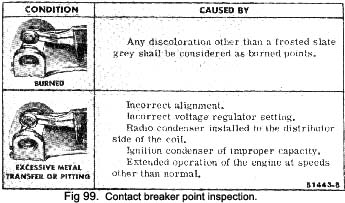|
excessive metal transfer between the points is
evident (Fig. 99). Metal transfer is considered excessive when
it equals or exceeds the gap setting. Any discolouration, other
than a frosted slate grey should be considered as burnt. Excessive
pitting or burning is caused by incorrect alignment. Incorrect
voltage regulator setting. Radio condenser installed to the distributor
side of the coil.
Ignition condenser of incorrect capacity probably
due to fitting incorrect or spurious spare replacement.
Coil and condenser
Test equipment incorporating an oscilloscope (scope) is needed
for the complete checking of the coil and condenser. If this equipment
is not available these units can only be checked by substitution
of new ones. Should the H.T. spark appear to be weak or thin after
the ignition circuit is found to be satisfactory a new con-denser
should be fitted. If this makes no improvement a new coil should
be fitted.
Preliminary checks
- Remove the coil to distributor high tension
lead and the spark plug wires from the distributor cap and
from the spark plugs. Inspect the terminals for looseness
and corrosion. Inspect the wires for breaks and cracked insulation.
Replace all defective wiring
- Clean the inside of the distributor cap,
and Inspect it for cracks, burned contacts, or permanent carbon
tracks. Remove dirt or corrosion from the sockets. Replace
the cap if it is defective.
- Inspect the rotor for cracks or other defects.
Replace the rotor if it is defective.
|
High tension leads
The secondary wires include the wires connecting the distributor
cap to the spark plugs and the wire connecting the centre terminal
of the distributor cap to the centre terminal of the ignition
coil.
These wires are the radio resistance type which filter out the
high frequency electrical impulses that are the source of Ignition
noise interference. The resistance of each wire should not exceed
24,500 ohms. When checking the resistance of the wires or
setting ignition timing, do not puncture the wires with a probe.
The probe may cause a separation in the conductor. At regular
intervals, clean and inspect the wires for cracked insulation
and loose terminals. Repair or replace the wires as ‘required.
A spark plug wire set is available for service.
When removing the wires from the spark plugs, grasp the moulded
cap only. Do not pull on the wire because the wire connection
inside the cap may become separated or the weather seal may
be damaged.
Continuity tests
HT leads can be checked with a good class voltmeter; having
a scale range of 0-20v used with the car 12v. supply.
This method of checking will detect “ breaks” that
the HT supply will jump and leave unnoticed until misfiring
begins.
Spark Intensity
- Disconnect a spark plug wire. Check the
spark intensity of one wire at a time.
- Install a terminal adaptor in the terminal
of the wire to be checked. Hold the adaptor approximately
.~. In. from the exhaust manifold and crank the engine, using
a remote starter switch. The spark
|
 **
**
